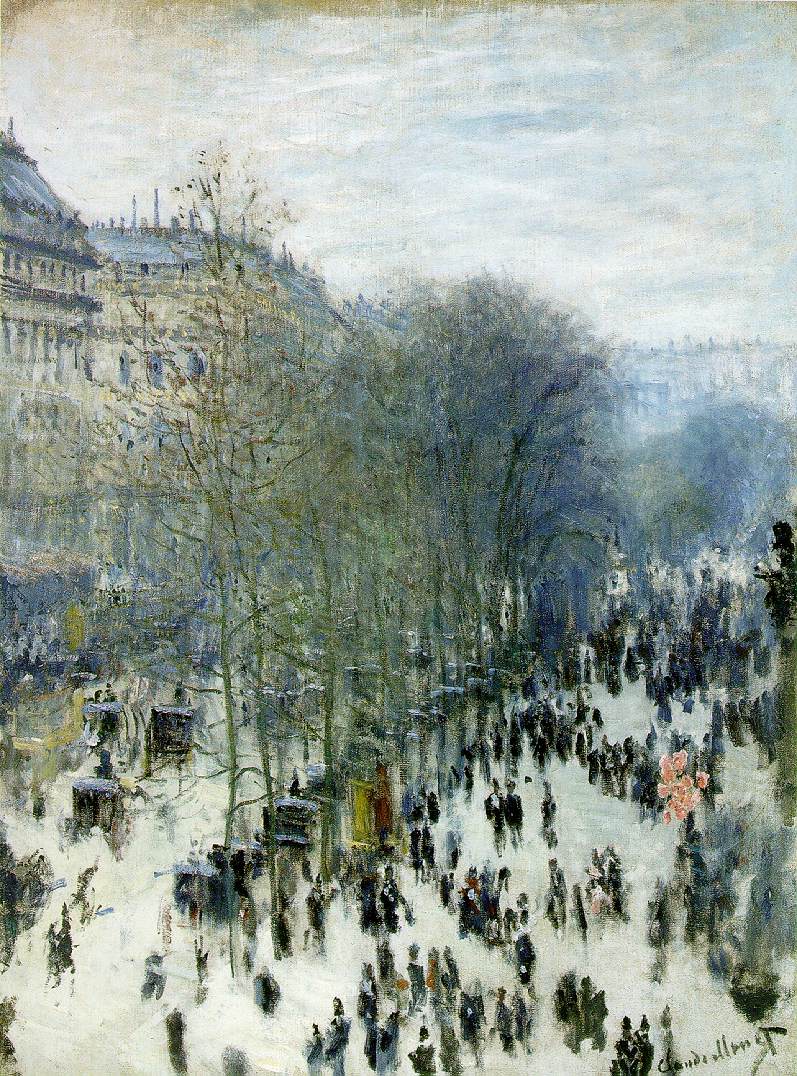 |
| Thomas Kinkade's "Cobblestone Bridge" |
Thomas Kinkade died last week at the ripe young age of 54. His family claimed it was natural causes, though I'm not going to go into speculation on what kind of natural causes would kill a middle-aged man with no history of diseases. That's the coroner's job. I never thought much of Mr. Kinkade or his art, mainly because I associated the Kinkade brand with those pretentiously-lit galleries at the mall, sugary sweet paintings that seemed to lifted from a preteen girl's sentimental brain, and how he stole the phrase "painter of light" from the Impressionists. That last one was the product of an art history degree, but the other two were just a sign that my tastes in paintings did not run the sweet gamet. In short, like many in the professional art world, I found his paintings kitschy and designed to appeal to the masses.
 |
| Monet's "Boulevards des Capucines" |
But then, looking at those images again, I thought, 'What is it about them?' What did he do that Monet, Renoir, Degas didn't do better and more vividly. Why are people paying more than
$800 for a Kinkade that is mass produced, sometimes retouched, and often times not even painted by the man? Wouldn't it just be cheaper to buy a framed and matted print of a rain-drenched Paris? At least then you know that you're looking at a real place that exists.
A degree in art history is useless if you don't use it so I'm going to put on my painterly hat/beret for a while. A Kinkade painting is mainly categorized with certain signature elements: pastoral scenes, pastel colors, some type of real estate (usually thatched cottage or church) and brightly lit. To use a certain art term, his paintings were romantic, looking at the world through rose-colored glasses.
 |
| Casper David Friedrich's "Wanderer above the Sea of Fog" |
And whenever there is typical beauty, there is a countermovement, which is to deviate towards the typically ugly. Things that are larger than life and imposing, or things that deconstruct the world and reveal the harshness beneath. Things that claim to be more real, more indicative of the world than that little house in the countryside. People who are not art connoisseurs or historians deviate towards works like Kinkade because they have always done so. After all, J.M.W. Turner was the romantic counterpoint to the Casper David Friedrich's sublime landscapes, one showing the comfort of the God-given world, and the other, the vast uncertainty of it all. Serat with his Pointillistic constructions was the counterpart to Renoir's fuzzy and light-bathed women. Both had their audiences and both had detractors.
 |
| Hirst's "Urea-13C" |
And today, while there are artists creating deconstructed work like Damien Hirst (another artist who has created a branded empire), there is the counterpart who draws pretty pictures. And that is what draws people to Kinkade's work, a contemporary painter who offers his audience a well-lit relief from the mechanical daily living, his pictures are pretty. He offers images of a world that is comforting, beautiful and better mannered than the world today. It's a world of "simple pleasures," that existed yesterday and that can exist today if we learned to live differently.
The Republican platform is based on that same notion, "family values," and a time where family was at the center of society, the wife supported her husband and children, and everybody went to church. One doesn't need to look far to know that
that promise is a lie and cannot exist. That world has never happened and will never happen, because humans are too messy and multifaceted to be satisfied with just one way of life. But Kinkade's paintings, like Republican ideology, gain traction and money because they make those lies seem real, and they tap into the desire for a simpler, less hard life, where all you needed for happiness is a beautiful house next to a river. So while the willingness to exploit those lies made Kinkade an unimaginative painter, it did make him one hell of a businessman.





No comments:
Post a Comment